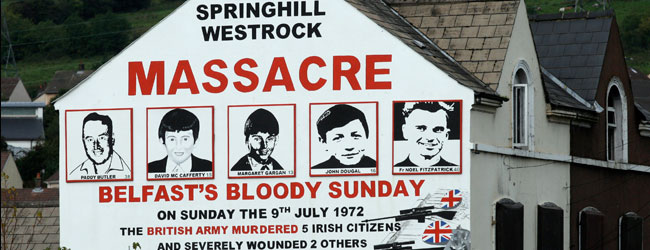At the Springhill Inquest the spotlight continued this week on the Royal Military Police (RMP) with the inquest hearing more evidence from another former member of the Royal Military Police. Known only as SM346 to protect his identity the inquest heard that he was the only person to have ever spoken to Soldier E who claimed he shot a “gunman” on the night of 9th July 1972.
SM346 who gave his evidence by video link claimed he could not remember taking a statement from Soldier E despite the fact that his signature was on the statement. It was clear from his evidence that the role of the Royal Military Police was nothing more than a ‘statement taking exercise’ and no effective proper investigation ever took place into the British soldiers who shot dead the five victims in the Springhill Massacre.
The role of RMP in British Army killings was examined in the Saville Inquiry (Bloody Sunday) and the following evidence from a military witness captures the ‘statement-taking’ process and the total lack of any investigation.
“It was not a formal procedure. I always wore civilian clothing, and the soldiers were relaxed. We usually discussed the incident over sandwiches and tea.”
This was certainly how SM346 described the process when he gave his evidence to the inquest this week. He wore civilian clothing when he would have been interviewing soldiers, including Soldier E who said he shot dead “gunmen”. In his fourteen years as a member of the RMP he never had to caution a soldier or even question their accounts about why they discharged their weapons, even if they had shot a civilian dead.
When asked by counsel for the families whether he investigated the account Soldier E described in his statement SM346 said he did not. Incredibly he told the inquest that he was given minimal information about the shooting incident and could not remember whether or not civilians had been killed. He said, “When you interviewed soldiers you didn’t know the extent of the injuries to the civilians”.
He went on to tell the inquest that he never visited Corry’s Timberyard, where the shots were fired from, or Springhill, where the victims were shot dead. The weapons of soldiers that had killed the five victims were never seized by the RMP for forensic examination. His response, like that of all of the other former soldiers who have given evidence, was that he had no recollection of the incident or of the identities of the soldiers who shot dead the victims.
After six weeks of hearing the evidence from over thirty military witnesses the inquest is still not able to identify the soldiers who murdered the three teenagers, a father of six and the parish priest. The seven soldiers involved in the deaths have still not been traced nor indeed has any of them come forward to give evidence for the inquest.
The inquest continues on Tuesday the 19th March.











